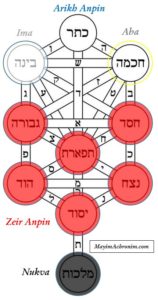This week we begin reading Shemot, the second book of the Torah. Commenting on Israel’s rapid population growth (Exodus 1:7), Rashi famously cites the Midrash that each woman gave birth to six children in a single pregnancy! This is a classic Midrash in the sense that it probably should not be taken literally. One way to make sense of it is to suggest that perhaps each woman produced six Jewish souls per pregnancy. We know that while there was a limited number of Israelites physically present in Egypt and at the Exodus, we maintain that all Jewish souls that ever lived or will live (including those of converts) were there spiritually. Jewish souls from across history were liberated from slavery in Egypt and experienced the Revelation at Sinai. That’s one reason the Passover Haggadah reminds us that each and every Jew at the seder should feel like he or she personally came out of Egypt. You did!
Back in Egypt, the physical Jewish population did indeed grow rapidly. However, when we read the detailed genealogical lists in the Torah, we find that family sizes were not disproportionally large. Amram and Yocheved had three children, Aaron had four, Moses just two. In fact, throughout the Torah family sizes seem relatively small. Isaac had two sons, and Joseph had two as well (that we know of). Abraham was one of three sons. He went on to have a single child with Sarah, one with Hagar, and six more with Keturah (who may or may not be the same person as Hagar). There’s a tradition that Abraham had a daughter, too. Jacob had two children from Rachel, two from Bilhah, two from Zilpah, and seven from Leah—six boys and a girl (like Abraham). The reason for this, from a mystical perspective, is quite evident.
When it comes to the Sefirot, six are described as “masculine”, and the seventh is the feminine Nukva. Higher above, the Sefirah of Binah is called Ima, the “mother”, while Chokhmah is called Aba, the “father”. In this arrangement, the first and highest Sefirah of Keter symbolizes God Above. So, there’s God, father, mother, the six sons, and the daughter. This is a complete mystical “family”. Is this, then, the ideal family on the physical plane as well?
Not exactly.
Fulfilling the Mitzvah
The above model of the mystical “family” is not meant to be taken literally either, nor is the ratio of six boys to one girl practical. In fact, the six masculine qualities are usually grouped into a singular partzuf called Zeir Anpin. The complete “family” then is God, father, mother, son, and daughter. This is indeed the accepted halakhic requirement, with the consensus of the Sages being that a person who has at least one daughter and one son has unquestioningly fulfilled the mitzvah of reproduction. This discussion of our Sages (in Yevamot 62a) is a fascinating one to explore.
It begins by citing Rabbi Natan in a Baraita that Beit Shammai held a person must have at least two boys and two girls to fulfil the mitzvah, while Beit Hillel held a person must have a minimum of one boy and one girl. As a general rule, of course, we always follow Beit Hillel. However, the Talmud then brings an alternate version of the same Baraita where Rabbi Natan teaches it was Beit Shammai who held the minimum to be one boy and one girl. Beit Hillel, meanwhile, held that either a single boy or a girl is enough to fulfil the mitzvah. Thus, we have three opinions: the minimalist being one child, and the most mehadrin being four children. From where in the Torah can we prove each opinion?
Regarding four children, Beit Shammai looks to the Garden of Eden for proof—after all, the mitzvah of reproduction was first given to Adam and Eve. In Genesis 4:2 we read that after having Cain, Eve went on to also have Abel. The language of the Torah is et achiv et Havel, with a redundant et. One of the rules of Torah exegesis is that a redundant et (את) must have some kind of extra meaning. The et here teaches us that Cain and Abel were each born with a twin sister. Thus, Adam and Eve had four children, and this is the minimum. (Among the twelve sons of Jacob that gave rise to the Twelve Tribes, we find that Reuben, Issachar, and Naftali all had four kids.)
Additionally, it makes sense to have four since the Torah phrases the mitzvah as pru u’rvu, literally “make fruit and multiply”. To have a child is enough to fulfil the pru part (having made a single fruit), but to fulfil the rvu part requires multiplication. If two people came together, then “multiplying” them would make four! (Rvu can literally mean “squared”, and two-squared is four.) Having said that, it can be logically argued that the four should include the original two (ie. two people became four people), so having two children is enough to fulfil the mitzvah fully. This might explain why so many great Biblical figures had two children, including Isaac, Joseph, and Moses; and why Jacob had at least two children from each of his four wives.
Regarding the most lenient opinion of Hillel—having a single child—the verse cited for proof is Isaiah 45:18, which says “He did not create it a waste; He formed it to be inhabited.” God created the Earth to be inhabited, so Beit Hillel argue that producing any additional inhabitant for Earth is enough to fulfil God’s Will. Abraham and Sarah had one child, and it appears King David had a single child with several of his wives (I Chronicles 3:1-2). Dan, the son of Jacob and one of the Twelve Tribes, had a single son: Chushim.
To summarize, having even one child is enough to fulfil the mitzvah, while having four might be considered an ideal, and in the Torah the maximum we see for any one married couple appears to be seven children. (Jacob did have thirteen, though with four wives. His son Gad had seven children, while Benjamin had ten through two wives. Earlier on, in Genesis 10, we saw that Yefet had seven children, too, following the Flood. The only figures who had a greater number of children were Canaan and Yoktan, but they likely had multiple wives.)
The Critical Factor
There are undoubtedly many factors when it comes to family planning. Some look to finances first, while others are primarily concerned with health (both of parents and children). Others might even look more broadly at the environment and human populations at large. There are many spiritual considerations, too, including a desire to boost dwindling Jewish numbers, to increase the potential for Torah and mitzvot, and to hasten the coming of Mashiach—as our Sages teach (on that same page of Talmud explored above, Yevamot 62a) that the Redemption will not come until all souls destined to live are born.
Each soul must be born because each soul has a reason for existing. Every soul has a unique purpose that it must fulfil before the story of mankind can come to its conclusion. Beautifully, the word for an infant is tinok (תינוק), a perfect anagram and numerical equivalent of tikkun (תיקון), since every child comes into this world with its own rectification. Having children is also a tikkun for the parents, of course, and is an enormous challenge that serves as one of the greatest tools for refinement.
When it comes to refinement, there are six major qualities we are meant to focus on in this world—the six middot of Zeir Anpin (see image above, in red): Chessed, kindness, love, and unconditional giving; Gevurah, restraint and self-discipline; Tiferet, balance and truth; Netzach, persistence, diligence, and faith; Hod, gratitude and acknowledgement; and Yesod, righteousness and sexual purity. Perhaps this is yet another deeper meaning behind the Midrash of the sextuplets, to remind us that bearing children comes with a tremendous responsibility and we mustn’t forget those six vital qualities—both to be developed within us, and to be instilled in our children.
And for those who, for reasons outside of their control, are unable to have physical children, let it be remembered that the unions of such couples are not fruitless: As the Arizal taught, they produce spiritual children, the souls of which become the new Jewish souls received by converts! We learn this from Abraham and Sarah, who could not have kids for many years but are said to have “made souls” nonetheless (Genesis 12:5). There are other spiritual rectifications at play in these situations as well. Suffice it to say, in the language of the Arizal’s scribe Rabbi Chaim Vital, that these unions “uphold entire spiritual worlds” (see the first mitzvah in Sha’ar HaMitzvot).
Having said all that, the most critical factor when it comes to planning the number of (physical) children is time. Unfortunately, time is limited, and there is only so much a person can accomplish in a day, and so much time that a person can devote to others. Each child requires from their parents a huge investment of time first and foremost. It is not enough to only feed the kids and keep them safe from harm—animals do that, too. What humans need is to spend direct quality time with their children, and the more the better.
The Torah speaks of time using the term sha’ah (שעה). In our daily lives, we often replace time with our children by giving them toys, games, and other entertainment instead—what would be called in the Torah’s language a sha’ashua (שעשוע). Comparing these two words, we find that a sha’ashua can literally be translated as a “time-filler”, or “time-spender”. We can learn from this that we should be giving our children less sha’ashuim and more of our sha’ah. In fact, God refers to Israel as His yeled sha’ashuim (Jeremiah 31:19), from which we can further learn that the child should be the sha’ashua for the parent, ie. spend time with your child instead of giving them something to spend time with!
With that, we can go back once more to the Midrash of the six. Why six? We have an interesting scientific phenomenon in that we use a base-10 metric scale for measuring just about everything—distance, mass, voltage, volume, etc.—except for measuring time. Instead of base-10, time is measured in base-6, in multiples of 6, with 60 seconds in a minute and 60 minutes in an hour and 24 hours in a day (we’ve explored elsewhere how a day is best structured in four segments of 6 hours).
And so, perhaps the hidden message of the Midrash in tying the number six to children is to consider the amount of time invested in each one, and to remember that proper parenting requires patience. To answer the original question, there is no ideal number of kids to have. It all depends on how much time can be devoted to them so that none are neglected and all can grow to be proper, fulfilled human beings, embodying the positive aspects of those six central middot. Some parents might have enough time for ten children while others struggle to have enough even for one.
In today’s fast-paced, complex, and over-burdened life, it can be very hard to find time. Yet, God commanded us to announce the new months and new years, and gave us a Torah calendar that is fluid and dynamic—even the value of an “hour”, a sha’ah, changes over the course of the year! It teaches us not to surrender to time or feel constrained by it, but rather to overcome its limitations and make time. After all, if modern science has taught us anything, it’s that time is relative.



Pingback: Mitzvot of Marriage (P#212-223) | Yad HaChazakah – יד החזקה